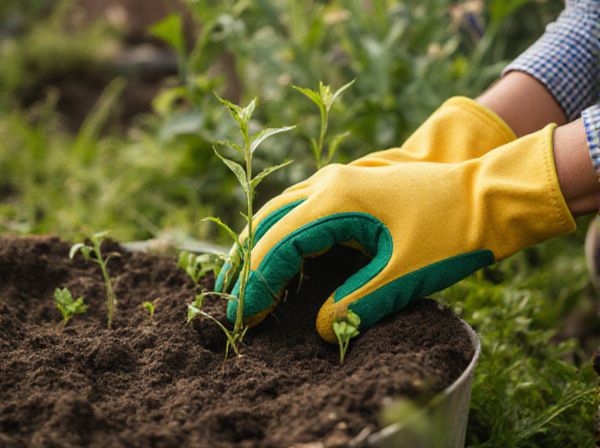
Direct seeding vs Transplanting Illustration
Direct seeding offers cost-efficiency and simpler planting by sowing seeds directly into the soil, promoting stronger root development and reducing transplant shock. Transplanting allows for better control over plant spacing and early growth conditions, leading to improved survival rates and potentially higher yields. Choosing between these methods depends on crop type, climate, and available resources.
Table of Comparison
| Aspect | Direct Seeding | Transplanting |
|---|---|---|
| Definition | Sowing seeds directly into the field | Growing seedlings in a nursery then planting |
| Establishment Time | Longer; depends on seed germination | Faster; seedlings already developed |
| Labor Intensity | Low; simple sowing | High; requires nursery care and transplanting |
| Cost | Lower; fewer inputs | Higher; nursery and transplant labor costs |
| Plant Density Control | Less precise; uneven spacing possible | Precise; controlled spacing and density |
| Risk Factors | Higher risk of seed failure, pests, and weeds | Lower risk; healthier seedlings reduce loss |
| Yield Potential | Variable; depends on seed conditions | Generally higher due to healthy starts |
| Suitable Crops | Beans, corn, grains, rice in wet conditions | Vegetables, rice, tobacco, crops requiring early growth |
| Environmental Impact | Less nursery resource use | More water and energy use in nursery |
Overview: Direct Seeding vs Transplanting
Direct seeding involves planting seeds directly into the soil, promoting natural root development and reducing labor costs, while transplanting requires starting seedlings in a controlled environment before moving them to the field, ensuring better early growth control and higher survival rates. Crop species, climate conditions, and soil quality significantly influence the choice between direct seeding and transplanting methods. Yield potential and disease management also vary, with transplanting often providing an advantage in managing pests and environmental stress during early plant development.
Factors Influencing Planting Method Selection
Soil type, climate conditions, and crop species strongly influence the choice between direct seeding and transplanting. Fields with well-drained, fertile soil favor direct seeding for rapid root establishment, while transplanting suits cooler climates that extend the growing season. Labor availability and equipment also determine the planting method, as transplanting demands more resources compared to direct seeding.
Advantages of Direct Seeding
Direct seeding offers advantages such as lower labor and material costs compared to transplanting, enabling more efficient large-scale cultivation. It reduces root disturbance, promoting stronger early root development and better plant establishment in the soil. This method also allows for quicker crop turnover and minimizes transplant shock, leading to higher overall crop yields.
Benefits of Transplanting Seedlings
Transplanting seedlings enhances early plant establishment by providing a controlled environment for germination, resulting in stronger root systems and higher survival rates. It allows for better spacing and weed management, which improves overall crop yield and quality. This method reduces vulnerability to pests and adverse weather conditions during the critical early growth stages.
Soil Preparation for Successful Planting
Direct seeding requires well-tilled, loose soil with consistent moisture to promote rapid germination and strong root development. Transplanting benefits from nutrient-enriched, well-drained soil with adequate organic matter to support seedlings during establishment and reduce transplant shock. Proper soil pH and texture adjustment enhance nutrient uptake and improve overall plant growth in both methods.
Ideal Crops for Direct Seeding
Ideal crops for direct seeding include grains like wheat, rice, and maize, which thrive when sown directly into prepared soil, allowing uniform germination and root development. Vegetables such as beans, peas, and carrots also benefit from direct seeding due to their sensitivity to transplant shock and rapid early growth. Direct seeding is particularly advantageous for crops adapted to local climates, reducing labor and transplanting costs while promoting natural plant establishment.
Best Plants for Transplanting
Tomatoes, peppers, and eggplants thrive when transplanting due to their long growing seasons and sensitivity to cold soil, allowing gardeners to extend the growing period indoors before moving seedlings outside. Brassicas such as broccoli, cauliflower, and cabbage also benefit from transplanting, as it helps young plants establish strong roots and resist pests in early growth stages. Herbs like basil and parsley develop better flavor and structure when started indoors and transplanted, ensuring stronger growth compared to direct seeding in unpredictable outdoor conditions.
Timing and Climate Considerations
Direct seeding allows crops to be sown directly into the field, making it ideal for warm-season plants that require stable soil temperatures above 50degF, thus reducing the risk of transplant shock. Transplanting is advantageous in cooler climates or shorter growing seasons, enabling seedlings to develop indoors before being moved outside once the threat of frost has passed. Timing for direct seeding hinges on soil warmth and moisture, while transplanting offers flexibility by starting plants early and ensuring healthier growth under controlled conditions.
Common Challenges with Each Method
Direct seeding often faces challenges such as uneven germination, higher vulnerability to pests and diseases, and difficulty in controlling soil moisture levels. Transplanting can lead to transplant shock, increased labor costs, and potential root damage that affects plant establishment. Both methods require careful management of environmental conditions to optimize plant growth and yield.
Tips for Maximizing Plant Growth and Yield
To maximize plant growth and yield, ensure direct seeding is done in well-prepared, moist soil to promote quick germination and strong root development. When transplanting, harden off seedlings by gradually exposing them to outdoor conditions and plant them deeply to encourage robust root systems. Use consistent watering and balanced fertilization tailored to the plant species for optimal nutrient uptake regardless of the chosen method.
Direct seeding vs Transplanting Infographic

 gardendif.com
gardendif.com